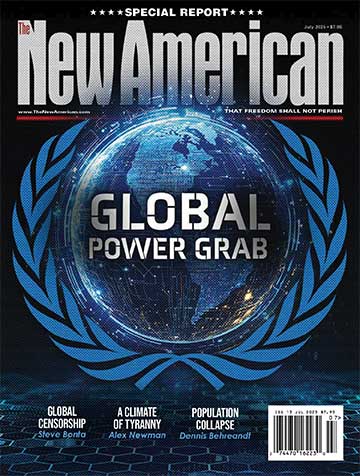
It has been called the “King of Fearmongers,” though it’s better known as the SPLC. Yet it’s again earning the quoted appellation, shamelessly faking an “Islamophobia” crisis — and using the ruse to fleece gullible donors.
FrontPage Mag’s Daniel Greenfield reports on the story, writing that the SPLC — which, aside from deception, stands for the Southern Poverty Law Center — made recent headlines by claiming that the “number of anti-Muslim hate groups increased almost three-fold in 2016,” from 34 in 2015 to 101 a year later. Writes Greenfield:
What could possibly account for that growth? Statistical fakery so fake that a Vegas bookie would weep.
… The SPLC decided to count 45 chapters of Act for America as separate groups.… [Yet] Act for America isn’t a hate group. It’s also just as obviously not 45 groups.
And it didn’t come into existence last year.
Act for America was only listed as one group in the 2015 list. It shot up to 45 now.
The SPLC this year listed the Los Angeles chapter of Act for America as a separate group. But the chapter has been around for quite a few years.
Furthermore Act for America boasts not 45, but 1,000 chapters across the country. Why list just 45 of them? Look at it from the SPLC’s perspective. Next year, it can add 200 chapters and claim that anti-Muslim hate groups once again tripled. And then it can do the same thing again the year after that.
No doubt — nobody manufactures hate groups like the SPLC. In a 2009 report ominously entitled “The Second Wave: Return of the Militias,” it claimed the election of our first black president had contributed to a proliferation of such groups. Yet the only hard data the SPLC appeared to present was, as the Sydney Morning Herald reported at the time, that according “to research released by the SPLC in February, there has been a 54-percent rise in racist groups in the United States, from 602 in 2000 to 926 in 2008” — during the presidency of the quite white George W. Bush.
Moreover, while the SPLC’s claim to fame was that it battled the Ku Klux Klan in the 1980s, in “recent years, the SPLC greatly expanded its definition of civil rights and hate groups to the point where any organization that opposes the left’s favored causes risks being labeled a hate group by the SPLC,” wrote American Thinker in 2012.
This can reach comical proportions. Greenfield mentions how the owner of a Pennsylvania bar named Casa D’Ice captured the organization’s attention by putting politically incorrect messages on a plastic sign outside his establishment. The SPLC didn’t target the bar or owner, however, but the sign — which it listed as a hate group. Perhaps just as guns supposedly fire themselves, that sign expressed itself.
Here are more entities on the SPLC’s hate-group list:
• Altra Firearms, which ran an ad vowing not to sell weapons to Hillary Clinton Supporters or Muslims.
• Bosch Fawstin, an artist added after he survived the terrorist attack on the Draw Mohammed cartoon contest, with which he had an association.
• The David Horowitz Freedom Center.
• The Jewish Political Action Committee.
• And the American College of Pediatricians, which apparently was targeted because it opposes the “transgender” agenda, warning that it’s harmful to allow children to live as a member of the opposite sex.
The SPLC’s unfair targeting has led to violence, too. In 2012, homosexual activist Floyd Corkins shot a man during an attack on the headquarters of the Family Research Council (FRC), a Christian traditional-values group, after learning of the FRC via the SPLC’s hate list.
Along with good judgment, something else the Southern Poverty Law Center isn’t acquainted with, at least through experience, is poverty. Its net worth is $315 million, money raised largely by scaring gullible donors with fake stories about Islamophobia and militia crises. As Harper’s Magazine reported in the 2000 essay “The Church of Morris Dees,” “Today, the SPLC spends most of its time — and money — on a relentless fund-raising campaign, peddling memberships in the church of tolerance with all the zeal of a circuit rider passing the collection plate.”
But making money was always the overriding goal of the SPLC’s founder, Morris “Sleaze” Dees (no, I didn’t invent that nickname), a direct marketer-cum-trial lawyer who worked for infamous segregationist George Wallace in 1958. As Harper’s also informed, “‘He’s the Jim and Tammy Faye Bakker [disgraced televangelists] of the civil rights movement,’ renowned anti-death-penalty lawyer Millard Farmer says of Dees, his former associate, ‘though I don’t mean to malign Jim and Tammy Faye.’”
Not that much of this money actually reaches the poor and “downtrodden” Dees claims to champion. Note that the SPLC’s entire legal staff, leftists all, quit in protest in 1986, upset that Dees ignored issues relevant to poor minorities in favor of donation-stoking drama.
Yet the larger issue is the intellectual poverty creating fertile ground for self-proclaimed campaigners against hate. After all, should hate even be the focus?
Consider: While hatred of people is not to be encouraged (ideas and actions are a different matter), it’s fair to say that most everyone hates something and most everything is hated by someone. Thus, most anything could be deemed a “hate group,” especially with the SPLC unable to differentiate between groups, individuals, and inanimate objects (the sign). So what will make the cut?
Would a religious group exhibiting consistent hatred of Satanism be on a list of “hate groups”?
How about a philosophical group that hates existentialism?
What of an anti-tobacco activist organization that hates smoking and often rails against smokers?
What about a liberal group that appears to hate Republicans?
And how about the SPLC, which may hate the groups on its hate list?
The point is this: Is hate really a good guide for determining who should be demonized? Anyone compiling a hate-group list is merely picking and choosing among hatreds.
Of course, all this presupposes that the world’s hate police can reliably distinguish between critiques driven by hate and those reflecting sober, objective analysis (and that they even care to do so). It also assumes that if there is hate, what’s hated isn’t a sin; or if it is, that the “hater” in question is hating the sinner and not just the sin.
In addition, it presupposes that people can’t ever embrace the right positions for the wrong reasons (i.e., the wrong kind of hatred) and that people never pave that infamous road to Hell by glomming onto error with good intentions.
Some will now counter that, obviously, in answer to the question, there has to be a “destructive” hatred. But that’s a modifier that modifies the principle, and there’s the rub. What’s destructive?
Before knowing this, we must have a well-formed moral compass so we can differentiate between good and evil. This is why, while leftist moderns will at times liken conservatives to medieval inquisitors, those inquisitors were infinitely more sane than leftist moderns.
They didn’t focus so much on “hate,” or greed or sloth or gluttony or lust, when visiting pariah status; they knew anyone could exhibit these sins. Rather, they’d charge a person with heresy: rejection of the Truth, or the good. Oh, you may disagree with their conception of Truth, but their logic was unassailable. Rejection of the good is by definition a bad thing.
Yet what of our leftists’ logic? We’re supposed to hate evil and sometimes scorn those who hate the good; thus, not all hate is created equal.
This is why, as with “equality” and “diversity,” “hate” has become a buzzword. Just as diversity and equality tell us nothing about the quality of our system, today’s “hate” label says nothing about quality of ideas. What it does do is provide leftists with a way to demonize opponents, raise money, and shut-down necessary debate. After all, a criticism of Islam or something else may or may not be valid, but we won’t find out if those leveling it are dismissed, thoughtlessly, as “haters.”
And isn’t this part of the goal? If you can’t win a debate with intellectualism, end it with insults.
Related articles:
Protecting Rights: Loyal Americans Targeted by the SPLC
Profiling and Criminalizing Political Dissent
Media Jump to Smear Right With Extremist Label




